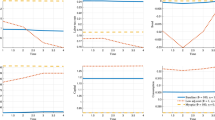Abstract
We develop a model of the behavior of a potential investor (under uncertainty and in a fiscal environment) who wishes to invest into a project in the real sector of an economy and faces a timing problem. We find an optimal solution within this model and examine the dependence of the tax revenue from the newly created firm on the depreciation policy. It is shown that there exists a domain in the space of the parameters of the investment project where both the tax revenue and the incentives can be increased by using the depreciation policy.
Similar content being viewed by others
References
Agliardi, E. (2001). “Taxation and Investment Decisions: A Real Option Approach.” Australian Economic Papers, 40, 44–55.
Amir, E., M. Kirschenheiter, and K. Willard. (1997). “The Valuation of Deferred Taxes.” Contemporary Accounting Research, 14(Winter), 597–622.
Arkin, V., A. Slastnikov, and E. Shevtsova. (1999). “Tax Incentives for Investment Projects in Russian Economy.” Working Paper No.99/03. Moscow: EERC.
Arkin, V.I. and A.D. Slastnikov. (2002). “Optimal Tax Depreciation in Stochastic Investment Model.” In G. Dzemyda, V. Saltenis, and A. Zilinskas (Eds.), Stochastic and Global Optimization. Dordrecht: Kluwer Academic Publishers.
Arkin, V., A. Slastnikov, and S. Arkina. (2003). “Investment Stimulation by a Depreciation Mechanism.” Working Paper No.02/05. Moscow: EERC.
Arkin, V. I., and A.D. Slastnikov. (2004). “Optimal Stopping Problem and Investment Models.” Dynamic Stochastic Optimization. Lecture Notes in Economics and Mathematical Systems, 532, 83–98.
Berg, M., A. De Waegenaere, and J. Wielhouwer. (2001). “Optimal Tax Depreciation with Uncertain Future Cash-Flows.” European Journal of Operational Research, 132, 197–209.
Cummins, J.G., K.A. Hassett, and R.G. Hubbard. (1996). “Tax Reforms and Investment: A Cross-Country Comparison.” Journal of Public Economics, 62, 237–273.
De Waegenaere, A. and J.L. Wielhouwer. (2002). “Optimal Tax Depreciation Lives and Charges under Regulatory Constraints.” OR-Spektrum, 24, 151–177.
De Waegenaere, A., R. Sansing, and J.L. Wielhouwer. (2003). “Valuation of a Firm with a Tax Loss Carryover.” Journal of American Taxation Association 2003 Supplement, 65–82.
Dixit, A.K. and R.S. Pindyck. (1994). Investment under Uncertainty. Princeton: Princeton University Press.
Forsfalt, T. (1999). “Taxation of Small Firms under Uncertainty—A Real Option View of Firm Creation.” Research Papers in Economics, 1999/0017. Stockholm: Stockholm University.
Hassett, K. and G.E. Metcalf. (1994). “Investment with Uncertain Tax Policy: Does Random Tax Policy Discourage Investment?” NBER Working Paper No. 4780.
Hu, Y. and B. Øksendal. (1998). “Optimal Time to Invest when the Price Processes are Geometric Brownian Motion.” Finance and Stochastics, 2, 295–310.
McDonald, R. and D. Siegel. (1986). “The Value of Waiting to Invest.” Quarterly Journal of Economics, 101, 707–727.
MacKie-Mason, J.K. (1990). “Some Nonlinear Tax Effects on Asset Values and Investment Decisions under Uncertainty.” Journal of Public Economics, 42, 301–327.
Mauer, D.C. and S.H. Ott. (1995). “Investment under Uncertainty: The Case of Replacement Investment Decisions.” Journal of Financial and Quantitative Analysis, 30, 581–605.
Niemann, R. (1999). “Neutral Taxation under Uncertainty—A Real Options Approach.” Finanzarchiv Neue Folge, 56, 51–66.
Øksendal, B. (1998). Stochastic Differential Equations. Berlin, Heidelberg: Springer.
Panteghini, P. (2001). “On Corporate Tax Asymmetries and Neutrality.” German Economic Review, 2, 269–286.
Roemmich, R., G. Duke, and W. Gates. (1978). “Maximizing the Present Value of Tax Savings from Depreciation.” Management Accounting, 56, 55–57.
Sureth, C. (2002). “Partially Irreversible Investment Decisions and Taxation under Uncertainty: A Real Option Approach.” German Economic Review, 3, 185–221.
Trigeorgis, L. (1996). Real Options: Managerial Flexibility and Strategy in Resource Allocation. Cambridge: MIT Press.
Wakeman, L. (1980). “Optimal Tax Depreciation.” Journal of Accounting and Economics, 1, 213–237.
Wielhouwer, J.L., A. De Waegenaere, and P.M. Kort. (2000). “Optimal Dynamic Investment Policy for Different Tax Depreciation Rates and Economic Depreciation Rates.” Journal of Optimization Theory and Applications, 106, 23–48.
Author information
Authors and Affiliations
Corresponding author
Rights and permissions
About this article
Cite this article
Arkin, V.I., Slastnikov, A.D. The effect of depreciation allowances on the timing of investment and government tax revenue. Ann Oper Res 151, 307–323 (2007). https://doi.org/10.1007/s10479-006-0121-9
Published:
Issue Date:
DOI: https://doi.org/10.1007/s10479-006-0121-9




